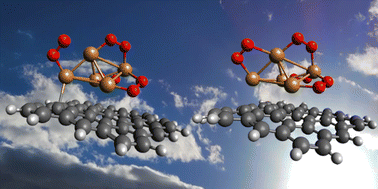Aggregation and support effects in the oxidation of fluxional atomic metal clusters. The paradigmatic Cu5 case†
Abstract
The recent development of new synthesis techniques has allowed the production of monodisperse metal clusters composed of a few atoms. Follow-up experimental spectroscopic characterization has indicated the stability of these atomic metal clusters (AMCs). Despite the common assumption that the occurrence of an irreversible oxidation becomes more likely as the cluster size decreases, its quenching and reversible nature has been experimentally identified in the particular case of Cu5 clusters, making them paradigmatic. This work aims to address the influence of aggregation and the effects of a chemically inert carbon-based support on the oxidation of AMCs, considering the case of Cu5 as a model system. For this purpose, we present an extended first-principles study of the oxidation of Cu5–Cu5 and circumpyrene-supported Cu5, comparing it with that of unsupported Cu5, and combine dispersion-corrected density-functionals, first principles thermochemistry, and ab initio molecular dynamics (AIMD) simulations within an adiabatic approach. Our results indicate that a molecular chemisorption/desorption model is sensible upon consideration of aggregation and support effects in such a way that the predicted (p–T)-phase diagrams do not differ significantly from those obtained for unsupported Cu5. We also provide insights into the decoupling of the Cu5–Cu5 dimer into Cu5 sub-units through activated fluxional rotational motion, upon heating, as well as the adsorption of multiple O2 molecules at high oxygen gas pressures. Furthermore, numerical evidence shows the likelihood of a support-mediated mechanism leading to the dissociation of chemisorbed peroxo O22− species, delivering states with very similar energies to those characterized by molecular chemisorption. A Boltzmann-weighted average of the free energies of formation is computed as well, coming up with a diagram of the dominant copper oxidation states as a function of temperature and oxygen gas pressure.

- This article is part of the themed collection: Stability and properties of new-generation metal and metal-oxide clusters down to subnanometer scale


 Please wait while we load your content...
Please wait while we load your content...